Learning the basics of healthy eating is key for a healthy life. I’ll share important techniques that boost well-being.
Choosing the right foods is essential for health. I’ll talk about macronutrients and share tips for daily life.
By the end, you’ll know how to make better food choices. This will help improve your health.
Key Takeaways
- Understanding the basics of healthy eating
- Importance of making informed food choices
- Practical tips for a healthy lifestyle
- Understanding macronutrients
- Improving overall well-being
Understanding the Basics of Nutrition
Knowing about nutrition is key for good health and weight control. It’s important to understand what we eat. This helps us make smart food choices.
Nutrition is complex, but breaking it down helps. The main parts are macronutrients, micronutrients, and water. Each one is important for our body’s needs.
Macronutrients Explained
Macronutrients give us energy and help our bodies grow. They are divided into three main types:
- Carbohydrates, our main energy source
- Proteins, important for fixing and building tissues
- Fats, key for storing energy and helping us absorb vitamins
Knowing how each macronutrient works helps us plan a diet. This diet supports weight management and health.
Micronutrients and Their Importance
Micronutrients are needed in small amounts but are very important. They include:
- Vitamins, key for energy and fighting off sickness
- Minerals, important for strong bones, nerves, and muscles
These micronutrients are vital for a balanced diet and good health.
The Role of Water in Diet
Water is often forgotten but is very important. It helps with digestion and keeps us energized. Drinking enough water is key for our body’s functions and weight management.
In short, knowing about nutrition is essential. It includes macronutrients, micronutrients, and water. By making smart food choices, we can improve our health and well-being.
Building a Balanced Plate
Building a balanced plate means knowing what nutrients your body needs. It’s more than just eating. It’s about giving your body the right foods. A balanced diet gives your body the vitamins and minerals it needs to work right.
Portion Control Strategies
Portion control is key to a balanced meal. Eating the right amount helps keep your weight healthy and ensures you get the nutrients you need. Here are some tips for portion control:
- Use a food scale to measure your food
- Eat slowly and stop when you feel satisfied, not full
- Avoid eating in front of screens
By controlling your portions, you can enjoy your favorite foods without overeating.
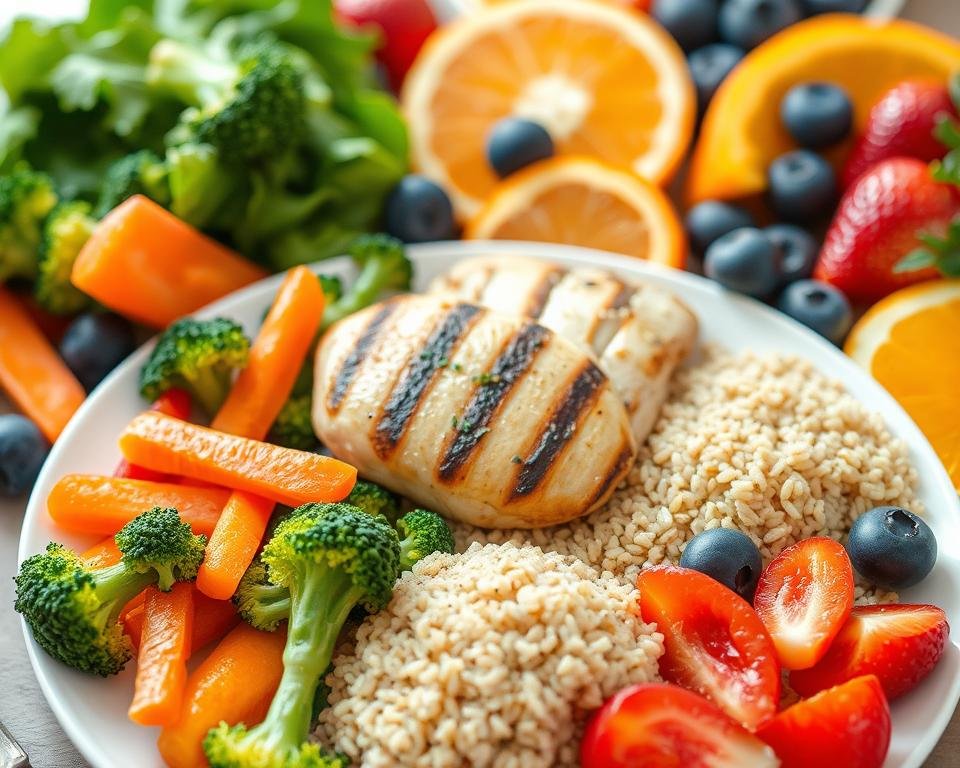
Food Groups to Include
A balanced plate has different food groups. These include:
- Protein sources like lean meats, fish, and legumes
- Whole grains such as brown rice, quinoa, and whole wheat bread
- A variety of colorful vegetables rich in vitamins and minerals
- Fruits, which provide essential fiber and antioxidants
- Healthy fats like nuts, seeds, and avocados
Having a mix of these food groups in your meals means you get a wide range of nutrients.
Sample Balanced Meals
Here are some examples of balanced meals that include different food groups:
| Meal | Protein Source | Vegetables | Whole Grains |
|---|---|---|---|
| Grilled Chicken with Roasted Vegetables and Quinoa | Grilled Chicken | Roasted Vegetables | Quinoa |
| Salmon with Brown Rice and Steamed Broccoli | Salmon | Steamed Broccoli | Brown Rice |
These meals are tasty and full of vitamins, minerals, and other important nutrients.
Meal Planning and Preparation Tips
Meal planning is a big help for a healthier life. It lets me choose what I eat, making sure I get the nutrients I need. Good meal planning has a few key steps to help me stay on track.
Setting Goals for Your Meals
I start by setting clear meal goals. I decide what meals I want, think about my diet needs, and plan for my busy days. For example, I make quick meals for busy days.
I also think about my nutrition goals. Maybe I want to eat more veggies or less carbs. Having a plan helps me make better choices and avoid unhealthy quick fixes.
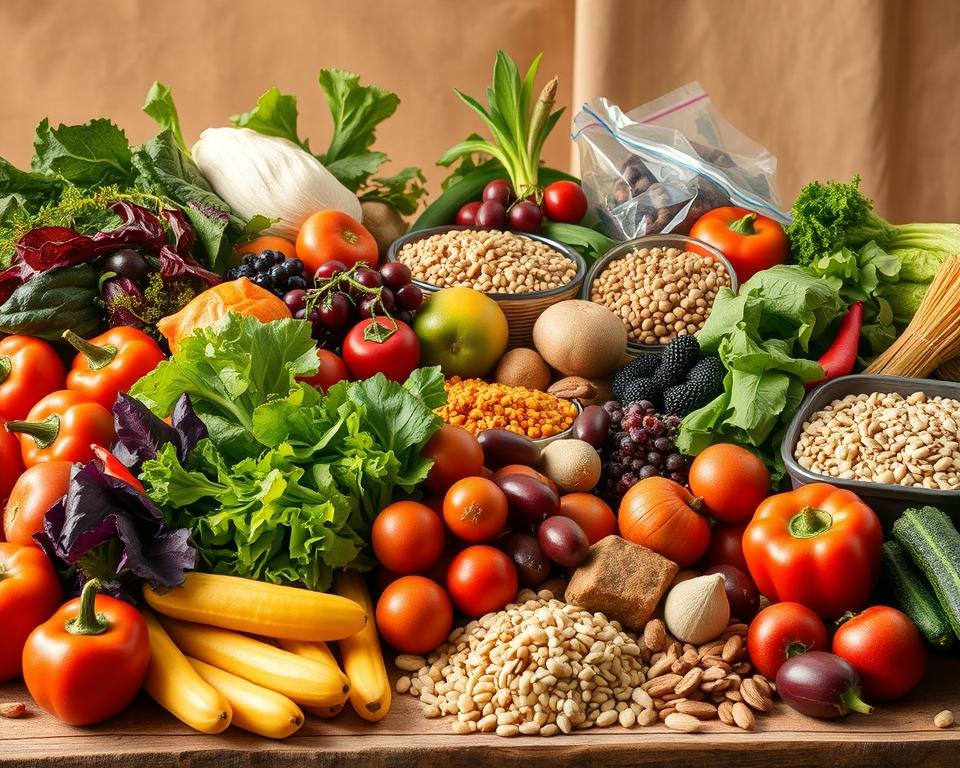
Preparing Meals Ahead of Time
Preparing meals early is key. This means cooking meals, getting ingredients ready, or making meals that can be cooked later. It saves time and helps me avoid fast food.
I love cooking big batches of grains or proteins on weekends. Then, I use them in many meals. For example, a big batch of roasted chicken can be in salads, wraps, or as a protein in many dishes.
Easy-to-Follow Meal Prep Ideas
For beginners, start with simple meal prep ideas. I often make overnight oats for breakfast, which I can change up with different toppings. Grilling chicken or fish for the week is another great idea.
- Make a week’s worth of salad jars by layering greens, veggies, and proteins.
- Cook a big batch of soup or stew for easy reheating.
- Roast different veggies for use in meals or as snacks.
Using these tips, I can eat a diet full of nutrient-rich foods easily. I avoid the stress of last-minute cooking and save money by not eating out.
The Importance of Fiber in Your Diet
Fiber is key for your health. It helps with digestion and keeps blood sugar levels healthy.
Types of Fiber and Their Benefits
Fiber comes in two types: soluble and insoluble. Soluble fiber lowers cholesterol. Insoluble fiber helps with bowel movements.
Soluble fiber is in oats, barley, nuts, and fruits. It makes you feel full longer.
Insoluble fiber is in whole grains, veggies, and wheat bran. It helps food move through your body faster.
| Type of Fiber | Food Sources | Health Benefits |
|---|---|---|
| Soluble Fiber | Oats, barley, nuts, fruits | Lowers cholesterol, slows digestion |
| Insoluble Fiber | Whole grains, vegetables, wheat bran | Aids bowel movements, adds bulk to stool |
How to Incorporate More Fiber
It’s easy to eat more fiber. Just make a few simple changes.
- Start with a high-fiber cereal for breakfast.
- Add more fruits and veggies to your meals.
- Choose whole-grain bread and pasta.
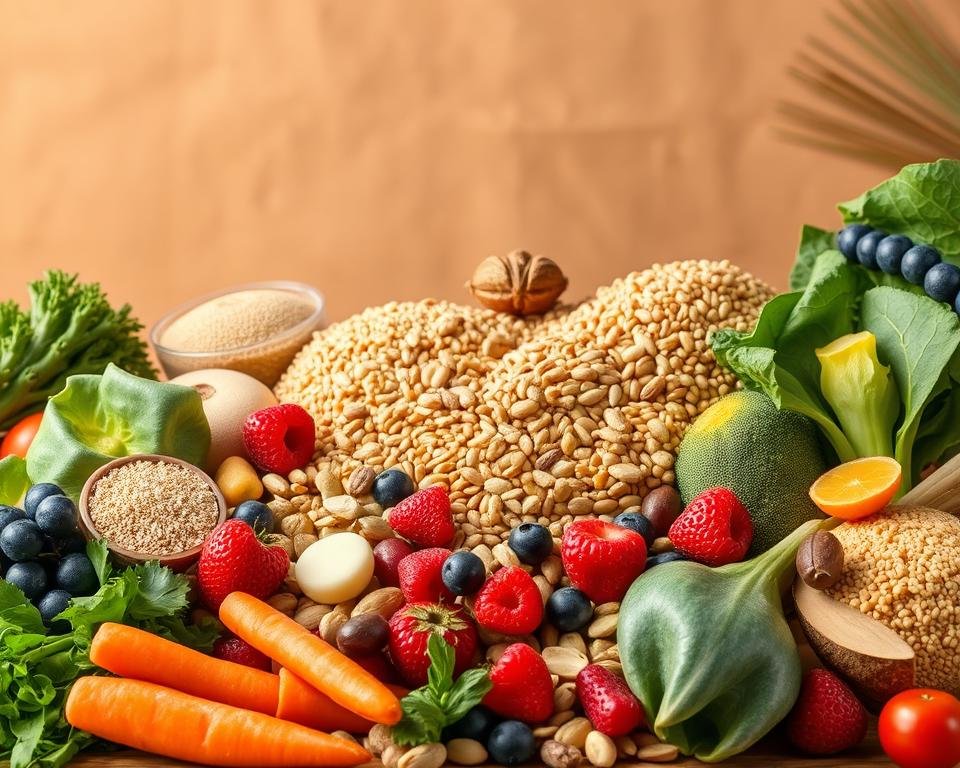
Common Myths About Fiber
Many people think fiber diets are too strict. But there are many tasty high-fiber foods.
Some think fiber supplements are as good as whole foods. But whole foods give you fiber, vitamins, and minerals that supplements don’t.
Nutrition for Special Diets
Following a special diet means knowing the dietary guidelines. This helps you stay on track and get the right nutrition. It’s important to know the specific needs for diets like vegetarian, vegan, gluten-free, or low-carb.
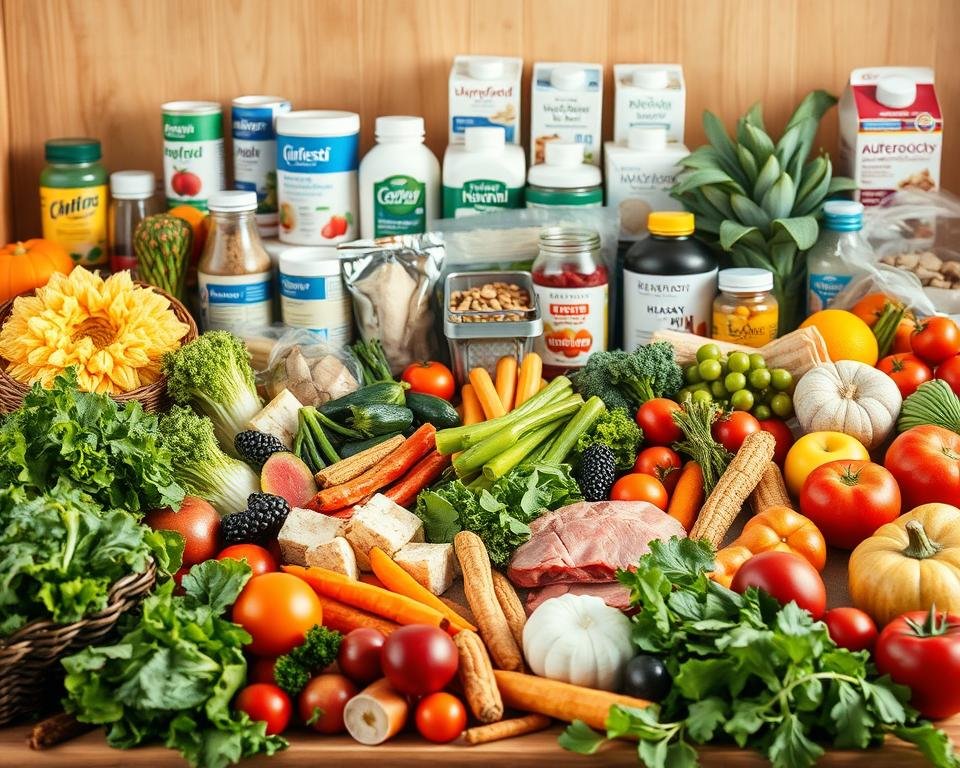
Vegetarian and Vegan Nutrition
Vegetarians and vegans need to make sure they get enough nutrients from plants. These nutrients are often found in animal products. Here are some key ones:
- Protein: Legumes, beans, lentils, and tofu are great sources.
- Vitamin B12: You can find it in fortified plant-based milk, cereals, and nutritional yeast.
- Iron: Dark leafy greens, beans, and fortified cereals are good. Vitamin C helps your body absorb it better.
- Calcium: Include fortified plant-based milk, dark leafy greens, and tofu in your meals.
Gluten-Free Eating
On a gluten-free diet, you need to swap out gluten for gluten-free options. Here’s what to do:
- Gluten-Free Grains: Use rice, quinoa, corn, and gluten-free oats instead.
- Read Labels: Always check food labels for gluten-free labels.
- Cross-Contamination: Be careful of gluten in foods you eat and where you eat.
Low-Carb Diet Basics
A low-carb diet means eating less carbs, focusing on low glycemic index foods. Here’s how to do it:
- Choose Protein-Rich Foods: Eat lean meats, fish, eggs, and plant-based proteins.
- Healthy Fats: Avocados, nuts, seeds, and olive oil are good choices.
- Low-Carb Vegetables: Leafy greens, broccoli, cauliflower, and other non-starchy veggies are best.
By following these guidelines, people on special diets can get the nutrients they need. They can also stick to their dietary choices or needs.
Reading Nutrition Labels
Learning to read nutrition labels helps us choose better food. When I go shopping, I always check the labels. It’s a simple way to make smart food choices.
The label has lots of info to help with meal planning. Knowing what’s in our food helps us plan better.
Serving Sizes Explained
The first thing to notice on a label is the serving size. This is key because all nutrition info is based on it. It’s important to know the serving size is not always what we eat.
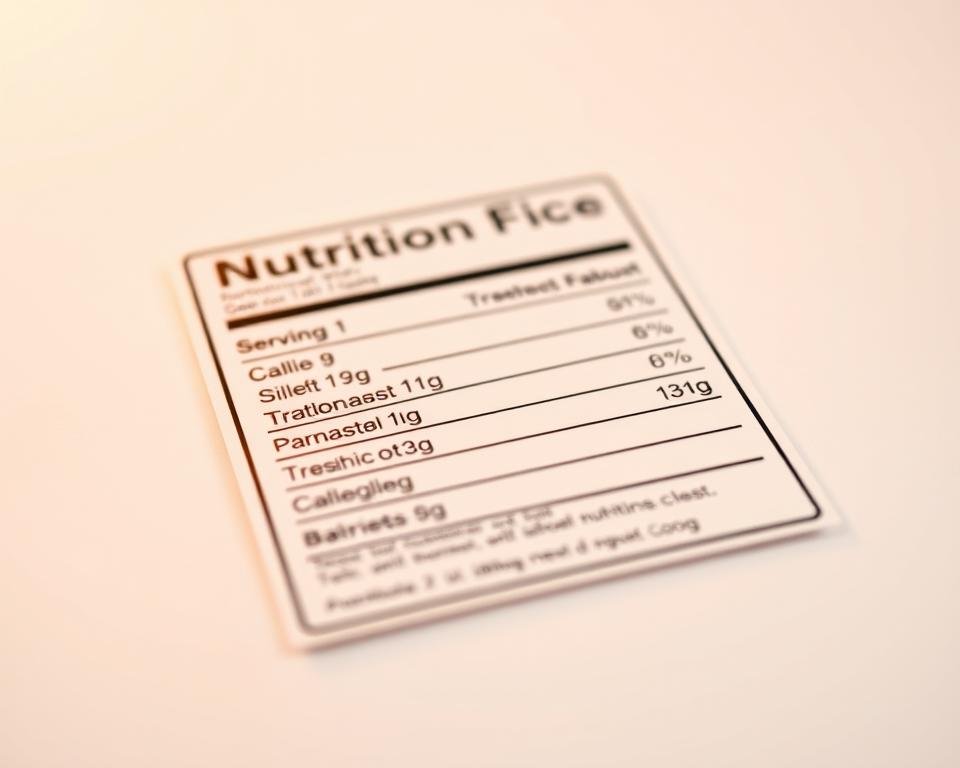
Key Nutritional Information
After understanding the serving size, we can look at the key info. This includes:
- Calories: Knowing the calorie count helps us control our energy.
- Macronutrients: Fats, carbs, and proteins are important for our body.
- Micronutrients: Vitamins and minerals keep us healthy.
By looking at these, we can see if a food fits our diet.
Common Misleading Claims
Food makers sometimes make claims that are not true. For example, “low fat” doesn’t mean it’s low in sugar. To avoid being tricked, I check the label and ingredients.
Terms like “natural,” “organic,” and “low calorie” might sound good. But they’re not always regulated. So, it’s important to check the label.
Knowing how to spot these tricks helps us make better choices. This supports our health and meal planning goals.
Smart Snacking Tips
Making smart snacking choices is key for a balanced diet. Snacking can be healthy if done right. Choose the right foods and be mindful of your snacking habits to reach your healthy eating goals.
Healthy Snack Ideas
Adding healthy snacks to your diet is easy and tasty. Here are some ideas:
- Fruits such as apples, bananas, or berries
- Nuts and seeds like almonds, cashews, or pumpkin seeds
- Veggie sticks with hummus or guacamole
- Protein-rich snacks like Greek yogurt or hard-boiled eggs
- Whole grain crackers with avocado or peanut butter
Strategies for Mindful Snacking
Mindful snacking means knowing what you eat and why. Here are some tips for mindful snacking:
- Pay attention to your hunger: Snack when you’re hungry, not just because you’re bored or stressed.
- Choose snacks that are nutrient-dense: Opt for snacks that are rich in vitamins, minerals, and fiber.
- Eat slowly and savor your snack: Take your time to enjoy your snack, paying attention to the taste, texture, and smell.
- Avoid distractions while snacking: Turn off the TV or put away your phone to focus on your snack.
Being mindful of your snacking habits leads to healthier choices. This supports your nutrition and healthy eating goals.
Hydration and Its Role in Nutrition
Hydration is key to nutrition, affecting energy and digestion. Water is vital for a balanced diet.
Drinking enough water helps with body temperature and digestion. A hydrated body absorbs nutrients better, making water essential for nutrition.
Daily Water Intake
Water needs vary by age, sex, weight, and activity. The usual advice is to drink eight glasses a day. But, some need more or less.
For a better guide, think about your weight. Drink half an ounce of water per pound. So, a 150-pound person should drink about 75 ounces daily.
| Body Weight (lbs) | Recommended Water Intake (oz) |
|---|---|
| 120 | 60 |
| 150 | 75 |
| 180 | 90 |
Signs of Dehydration
Dehydration can sneak up on you. Look out for headaches, fatigue, and dry mouth. Severe dehydration can cause dizziness and fainting.
Drink water all day to avoid dehydration. Check your urine too. If it’s pale yellow or clear, you’re good.

Hydrating Foods
Eating hydrating foods also helps. Cucumbers, watermelon, and celery are good choices. They add water and nutrients to your diet.
These foods boost your fluid intake and nutrition. Eating a variety supports a balanced diet and health.
Cooking Techniques that Preserve Nutrients
Cooking techniques are key to keeping vitamins and minerals in food. The way we cook can change how much nutrition we get. Choosing the right cooking methods helps keep food full of good stuff.
Boiling vs. Steaming
Boiling and steaming are two ways to cook veggies. Boiling can wash away vitamins like C and B. Steaming, though, keeps more of these important nutrients.
Steaming is better than boiling:
- Keeps more vitamins and minerals
- Helps veggies stay colorful and fresh
- Less loss of water-soluble vitamins
Baking and Roasting Options
Baking and roasting use dry heat to cook. They’re good for veggies, meats, and fish. These methods are better than frying for keeping nutrients.
How to bake and roast well:
- Use little oil to cut down on calories.
- Set the right temperature to avoid overcooking.
- Use herbs and spices for flavor without salt.
The Benefits of Raw Foods
Eating raw foods is great. Fruits and veggies are full of vitamins, minerals, and enzymes. They give us nutrients that cooking can take away.
Why eat raw foods:
- They’re packed with vitamins and minerals
- Have enzymes that help with digestion
- Are refreshing and can fill you up

In short, how we cook matters a lot. Steaming, baking, roasting, and eating raw foods help keep nutrients in our food. This makes our diet better and helps us stay healthy.
Making Nutrition a Lifestyle
Embracing nutrition as a lifestyle means adopting habits that last. It’s about knowing how nutrition facts affect your food choices.
Setting Realistic Goals
To make lasting changes, setting realistic dietary goals is key. Understand your nutritional needs and plan meals that follow dietary guidelines. Good meal planning keeps your diet balanced.
Overcoming Obstacles
Common challenges, like unhealthy eating habits, can be beaten. Be mindful of your food choices and prep meals ahead. Knowing nutrition labels and serving sizes helps too.
Staying on Track
Having support in your nutrition journey is important. Whether it’s a community or a healthcare professional, their guidance helps you meet your dietary goals.
FAQ
What are the essential nutrition techniques everyone should know?
Knowing about macronutrients and making smart food choices is key. Building a balanced plate and meal planning are also important. Plus, learning how to prepare meals is essential.
How can I ensure I’m getting the right balance of vitamins and minerals in my diet?
Eat a variety of foods rich in nutrients. Include fruits, veggies, whole grains, lean proteins, and healthy fats. Following dietary guidelines can also help.
What are some effective portion control strategies?
Use a food scale or measuring cups to control portions. Compare sizes to your hand. Pay attention to serving sizes on labels.
How can I incorporate more fiber into my diet?
Eat more fruits, veggies, whole grains, and legumes. Add nuts and seeds to meals and snacks for extra fiber.
What are some common myths about fiber?
Some think a high-fiber diet is hard or unnecessary. But, a balanced diet with enough fiber offers many health benefits.
How can I make informed food choices when following a special diet?
Know the dietary guidelines for your special diet. Plan meals that fit your needs, like vegetarian or vegan.
What are some tips for reading nutrition labels effectively?
Look at serving sizes and key nutritional info like calories and fat. Be cautious of misleading claims.
How can I stay hydrated and support my overall nutrition?
Drink plenty of water and eat hydrating foods like fruits and veggies. This helps with fluid intake.
What cooking techniques help preserve nutrients in food?
Steaming, baking, and roasting are good for nutrients. Boiling can lose water-soluble vitamins. Raw foods are also beneficial.
How can I make nutrition a sustainable part of my lifestyle?
Set realistic goals and plan ahead to overcome challenges. Find support from others or a healthcare professional to stay on track.



